7 Best Coaching Models Demystified: Proven Frameworks for Unlocking Potential

In the ever-evolving landscape of leadership and talent development, traditional annual performance reviews are rapidly giving way to continuous, structured coaching conversations.
And for good reason: according to Workhuman's research with Brandon Hall Group, 70% of organizations report that employees now demand more frequent feedback and coaching from their managers.
Moreover, companies that successfully foster a strong coaching culture are 51% more likely to report higher revenue than their industry counterparts. Clearly, coaching isn't just beneficial – it's essential to competitive advantage.
Despite the widespread acknowledgment of coaching's benefits, many leaders still approach coaching conversations casually or intuitively, missing out on the full potential that structured coaching models provide.
These proven frameworks offer clear, step-by-step roadmaps to help managers and executives guide conversations effectively, unlocking deeper engagement and driving measurable performance improvements.
In this ultimate guide, we'll explore the most impactful coaching models and frameworks—like GROW, CLEAR, OSKAR, and more – backed by real-world examples and robust research studies. We'll go beyond simply defining these models; we'll show you precisely how they can transform your coaching conversations from good intentions into strategic development assets.
Whether you're a seasoned executive or a manager aspiring to elevate your team's performance, this guide will equip you with actionable insights to harness the power of structured coaching and transform your organization's human potential.
What are coaching models (and why do they matter)?
Coaching models are structured frameworks designed to guide conversations between coaches (managers, leaders, or professional coaches) and coachees (employees or clients).
Think of them as roadmaps that ensure coaching sessions are goal-oriented, structured, and consistently impactful. They typically outline clear stages—from defining objectives to planning concrete next steps—transforming vague conversations into targeted, measurable actions.
Why coaching models matter to your organization
- Consistency & clarity: Without a structured model, coaching sessions can vary greatly in quality and focus. A defined coaching model ensures essential steps aren't missed, leading to consistent and reliable outcomes.
- Improved performance: Research shows that when coaching is combined with training, productivity increases dramatically – by up to 86%, compared to just 22% with training alone (Workhuman-Brandon Hall Group, 2018).
- Enhanced employee engagement: Effective coaching directly correlates to higher employee engagement. Workhuman’s research highlights that employees who receive regular coaching and feedback report higher job satisfaction and are more likely to stay committed to their organization.
- Stronger leadership & culture: Coaching models help cultivate a supportive, growth-oriented company culture. According to Workhuman, organizations prioritizing frequent feedback and coaching experience significant boosts in collaboration, innovation, and overall employee morale.
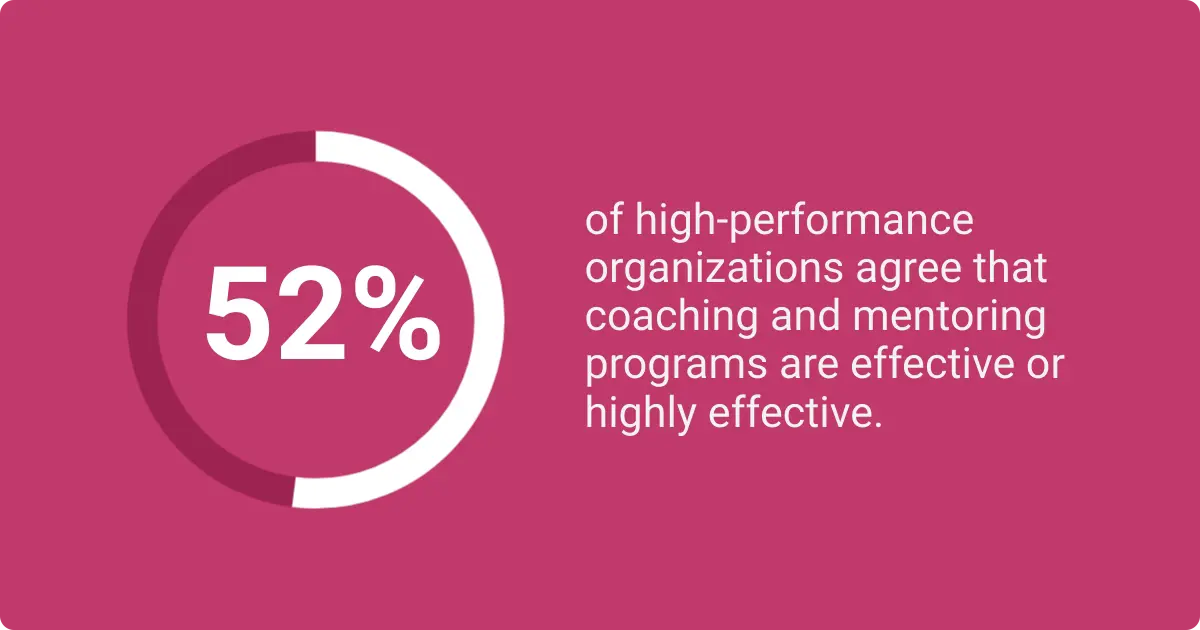
Quick reference table: Popular coaching models
| Coaching models | Key benefits | Ideal use cases |
| GROW Model | Goal clarity, practical problem-solving, simplicity | Performance management, specific goal-setting, skill improvement |
| OSKAR Model | Solution-focused, resource-oriented, boosts positivity | Complex situations, overcoming obstacles, confidence-building |
| CLEAR Model | Builds trust, deepens understanding, strengthens relationships | Sensitive issues, new team members, leadership development |
| FUEL Model | Structured dialogue, measurable outcomes, performance-oriented | Leadership coaching, performance management, measurable outcomes |
| STEPPA Model | Addresses emotional and psychological factors, holistic approach | Situations involving emotional barriers, mindset development |
| WOOP Model | Combines motivation with obstacle management, psychological grounding | Goal achievement, habit formation, personal and professional growth |
| Peer Coaching | Enhances mutual support, knowledge sharing, and team cohesion | Cross-functional teams, new leader training, collaborative environments |
This table offers a quick reference to help you identify which coaching models may best suit specific scenarios in your organization. Next, we'll explore each of these models in greater detail, backed by real-world applications and robust research.
7 Types of coaching models and frameworks
1. The GROW model: A simple, goal-focused coaching framework
If you’re looking for a structured yet flexible coaching method, the GROW model is one of the best tools available. Designed to streamline coaching conversations, this four-step framework – Goal, Reality, Options, and Way Forward – helps individuals clarify their objectives, assess their current situation, explore possibilities, and commit to action.
Originally developed in the 1980s by coaching pioneers like Sir John Whitmore, the GROW model remains a go-to strategy for leaders, mentors, and coaches across industries.
Breaking down the GROW coaching model
Goal: Define the target. Every successful coaching session starts with a clearly defined goal. This isn’t just about vague aspirations – it’s about setting measurable, specific objectives. A coach might ask:
- “What exactly do you want to achieve?”
- “What does success look like for you?”
- “How will you know when you’ve reached your goal?”
In a business setting, a goal could be:
- “Increase my monthly sales by 15% in the next quarter.”
- “Feel confident delivering presentations to executive teams.”
Reality: Assess the current state. Once the goal is set, it’s time for an honest evaluation of where things stand. This step involves analyzing strengths, challenges, and external factors that might impact progress. Some key questions include:
- “Where are you right now in relation to your goal?”
- “What obstacles or limitations do you face?”
- “What has contributed to your current situation?”
Example: A sales professional might realize they’re currently 5% below their target and struggle with cold outreach, while a manager seeking better executive presence might recognize they’re comfortable with technical discussions but uneasy when speaking to senior leadership.
Options: Explore potential strategies. This step is all about brainstorming – what actions could lead to progress? The coachee should take the lead in generating ideas, with the coach guiding the discussion. Helpful prompts include:
- “What are some possible ways to reach your goal?”
- “What has worked for you in the past?”
- “Who could support you in this process?”
For instance, a sales professional might consider adopting a new script, increasing outreach efforts, or seeking mentorship programs. A manager working on executive presence might enroll in a public speaking course, rehearse with a mentor, or practice in smaller meetings.
Way forward: Turn ideas into action. Now, it’s time to commit to specific next steps. This is where accountability comes in – setting deadlines, tracking progress, and ensuring follow-through. Questions to solidify the plan include:
- “What concrete actions will you take?”
- “When will you complete them?”
- “How will you stay accountable?”
Example: A salesperson might decide, “I will make three extra client calls per week and check in with my manager bi-weekly to track progress.” Meanwhile, the manager could commit to “Joining a Toastmasters group and delivering an update in our next team meeting to practice public speaking.”
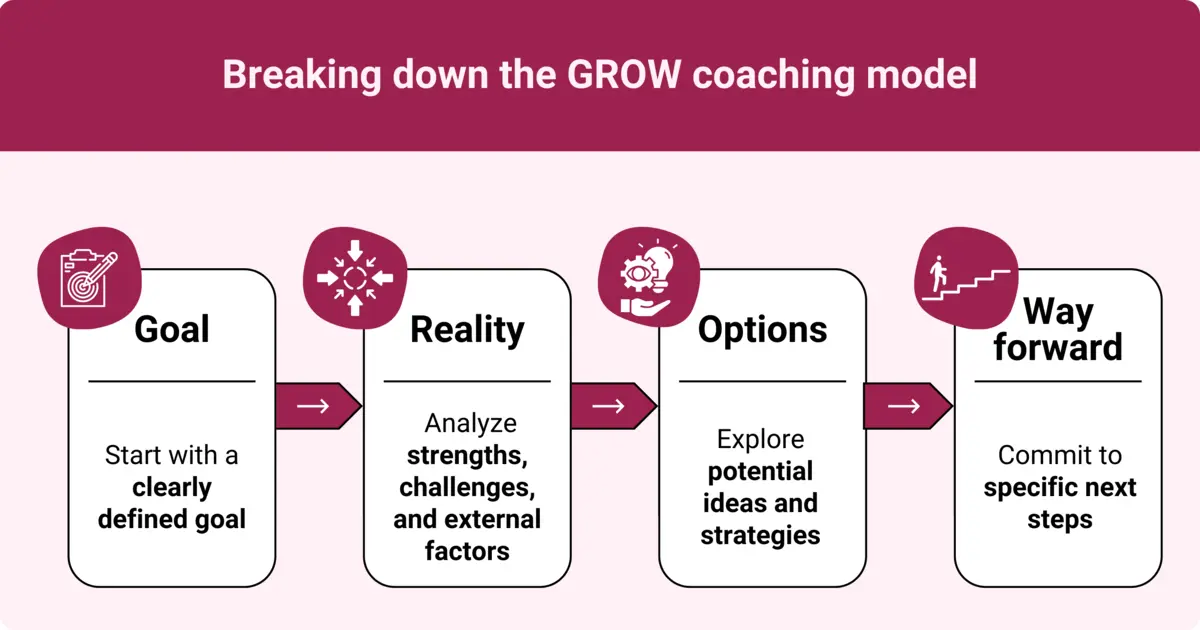
Why the GROW model works
What makes GROW so effective? Simplicity and adaptability. Whether you're coaching a new manager, mentoring a team member, or working on professional development, the framework keeps conversations focused on solutions instead of dwelling on problems.
It’s widely used in sales coaching, career advancement strategies, leadership training, and performance management – any scenario where structured goal-setting can drive results.
Real-world example: From challenge to clarity
Meet Sarah, a marketing manager aiming to improve her team’s campaign ROI (Goal). In a coaching session, she acknowledges that her current approach relies too heavily on a single channel, yielding diminishing returns (Reality).
Through brainstorming, she explores new possibilities: testing different ad formats, reallocating the budget, and expanding into underutilized platforms (Options). Finally, she sets a concrete plan: “Over the next quarter, I will pilot two new advertising platforms and track their effectiveness, with bi-weekly check-ins to discuss results” (Way Forward).
By the end of the session, Sarah has not only a clear roadmap but also a renewed sense of confidence—a hallmark of an effective GROW coaching style.
2. The OSKAR model: A solution-oriented coaching approach
When someone feels stuck, overwhelmed, or uncertain about how to move forward, the OSKAR model provides a structured way to shift focus from problems to solutions. This five-step coaching framework – Outcome, Scale, Know-how, Affirm & Action, and Review – guides individuals or teams toward clear, actionable progress rather than dwelling on roadblocks.
While some practitioners use a slightly different version called OSCAR (Outcome, Situation, Choices, Actions, Review), the core idea remains the same: coaching should be forward-looking and build on strengths, not just dissect challenges.
Breaking down the OSKAR coaching model:
Outcome: define the desired future state
Instead of focusing on what’s wrong, the coach helps the coachee articulate a positive end goal – what success looks like once the challenge is resolved. Key questions include:
- “What do you want to achieve?”
- “If this issue were completely resolved, what would be different?”
- “What impact would achieving this outcome have on you or your team?”
Example: A team struggling with missed deadlines might set an outcome like, “Projects are consistently completed on time with high-quality output and less team stress.”
Scale: measure where things stand today
Instead of a vague assessment, the coachee rates their current situation on a scale of 1 to 10, where 10 represents the desired outcome. This approach helps gauge progress objectively. The coach might ask:
- “On a scale from 1 to 10, where are you right now?”
- “Why a 4 and not a 2? What’s already working?”
- “What small improvement would move you one step closer?”
Example: A team might rate themselves a 4, recognizing that while some milestones are met, communication gaps slow things down. Instead of focusing on failures, the conversation now highlights what’s already working – a key element of OSKAR’s solution-focused mindset.
Know-how & resources: leverage existing strengths
This step shifts attention to what the coachee already knows or has access to which can help bridge the gap. The coach prompts reflection with:
- “What has helped you succeed in similar situations before?”
- “What resources or skills do you already have that could be useful here?”
- “Who else could support you in this process?”
Example: A team struggling with deadlines might realize that in past projects, weekly sprint planning kept them on track – a method they could reinstate. Or they might recognize underutilized project management tools that could help automate deadlines.
Affirm & action: encourage and commit to next steps
This stage involves two key elements:
- Affirmation: The coach reinforces the coachee’s strengths and progress, boosting confidence. “You’ve already identified great tools and strategies – it’s clear you’re committed to solving this.”
- Action: The coachee chooses concrete next steps based on what they’ve discovered. The coach helps ensure the plan is realistic and actionable, asking:
- “What specific steps will you take next?”
- “What’s the first thing you can do today to move forward?”
- “How will you hold yourself accountable?”
Example: The team might decide to introduce a 10-minute daily stand-up meeting to check progress and set automated deadline reminders in their project management tool.
Review: track progress and adjust as needed
Coaching isn’t a one-time event – it’s a process. Regular review sessions help ensure progress is measured, challenges are addressed, and adjustments are made where necessary.
The coach might ask:
- “Let’s check in two weeks from now—what will success look like by then?”
- “On a scale of 1 to 10, where do you see yourself after implementing these changes?”
- “What’s working well so far, and what might need tweaking?”
Example: The team schedules a follow-up in two weeks to evaluate if the new stand-ups and reminders are improving efficiency. If needed, they refine their approach based on real results.
Why OSKAR works
What makes the OSKAR model so effective? It flips the script. Instead of fixating on failures, it encourages a proactive, strengths-based mindset – perfect for teams or individuals who feel discouraged or stuck.
Rather than asking, “Why do we keep missing deadlines?” (problem-focused), OSKAR reframes the conversation to, “When have we met deadlines successfully, and how can we build on that?” (solution-focused).
Real-world example: coaching John toward better attendance
John, an employee with a history of frequent absences and tardiness, is struggling to meet company expectations. Instead of reprimanding him, a manager using OSKAR would guide him toward an actionable solution:
- Outcome: “John meets the company’s attendance expectations – no more than two absences per quarter, no tardiness.”
- Scale: John rates himself a 5 out of 10, recognizing that while he’s often late, he has had some good attendance stretches.
- Know-how & resources: They discuss what has helped John be on time in the past – for example, preparing his work materials the night before and using a carpool.
- Affirm & action: The manager acknowledges John’s willingness to improve and helps him commit to solutions: using a calendar app with reminders, adjusting his commute, and communicating absences in advance.
- Review: They schedule a one-month follow-up to check progress and reassess John’s self-rating on the scale.
By emphasizing solutions over blame, OSKAR helps John feel supported rather than criticized, making meaningful behavior change more likely.
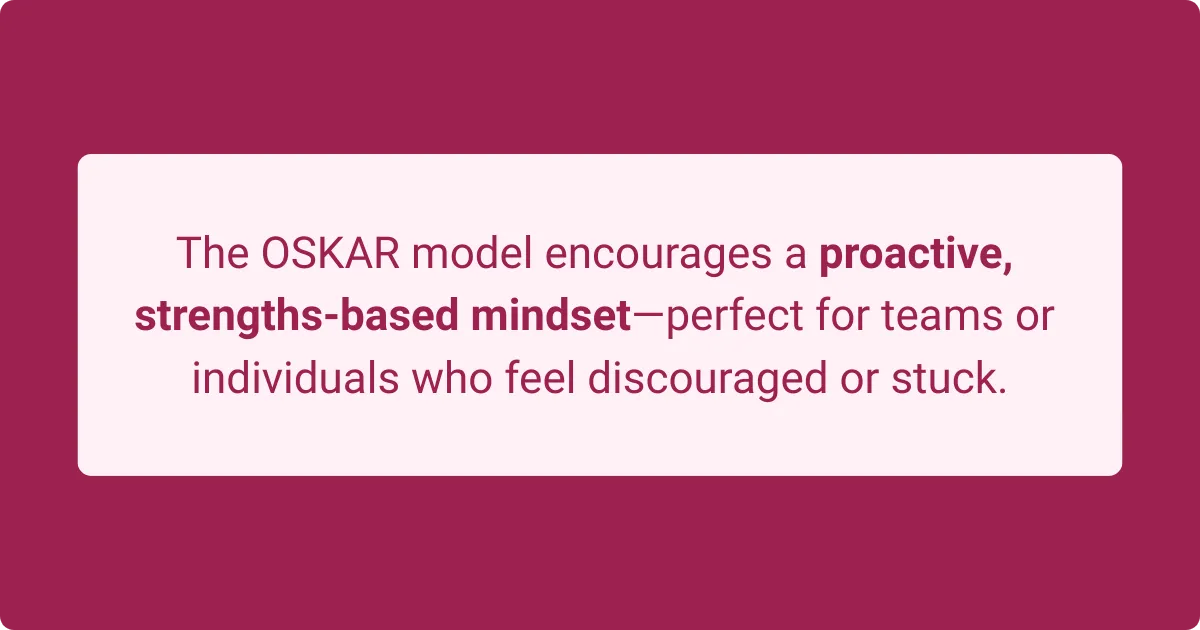
3. The CLEAR model: Building trust and clarity
The CLEAR model is a relationship-driven coaching framework designed to build trust, understanding, and clarity before diving into action. Developed by Peter Hawkins in the early 1980s, this five-step model – Contract, Listen, Explore, Action, and Review – is especially effective for individuals who are new to coaching, hesitant to open up, or navigating complex challenges.
Unlike more action-oriented models, CLEAR prioritizes deep listening and exploration, ensuring that coaching conversations lead to meaningful, self-directed solutions.
Breaking down the CLEAR coaching model:
Contract: setting the foundation for coaching
Here, “contract” doesn’t mean a legal document – it’s about establishing expectations, trust, and goals. The coach and coachee agree on what the coachee wants to achieve, how the conversation will unfold, and any boundaries (such as confidentiality).
Key questions include:
- “What would you like to focus on today?”
- “How can I best support you in this session?”
- “What outcome would make this conversation valuable for you?”
Example: A manager acting as a coach might say, “We have one hour together, and everything we discuss stays between us. How can I best help you today?” In a business setting, contracting could also involve aligning coaching with company goals, such as, “Over the next three months, we’ll focus on improving your project management skills.”
Listen: creating a safe space for honest dialogue
Great coaching starts with deep, empathetic listening. In this phase, the coach gives the coachee space to share their thoughts, challenges, and emotions without interruption. The goal is to understand fully before offering solutions.
The coach might use phrases like:
- “Tell me more about that.”
- “What’s been on your mind the most?”
- Paraphrasing or reflecting back on key points to confirm understanding.
Example: If a software engineer feels overwhelmed by tight deadlines, the coach doesn’t immediately suggest time management tips. Instead, they listen carefully to workload concerns, stress levels, and internal struggles, creating a foundation of trust and psychological safety.
Explore: uncovering insights and possibilities
Now, the conversation moves toward digging deeper into challenges, assumptions, and beliefs. This phase is not about jumping straight to solutions but helping the coachee gain clarity on what’s really happening.
Thought-provoking questions include:
- “What do you think is really causing this challenge?”
- “How do you feel about the expectations set for you?”
- “What might be holding you back?”
Example: A struggling engineer might realize that prioritization, not workload, is the real issue – or that fear of asking for help is making tasks feel overwhelming. The coach could ask, “What would happen if you involved your manager earlier?” or “What makes asking for help difficult?” These insights open new paths forward.
Action: turning insights into tangible steps
After exploration comes execution. But rather than prescribing solutions, the coach helps the coachee identify their own next steps – increasing buy-in and motivation.
Key prompts include:
- “What steps do you feel ready to take?”
- “Given what we’ve discussed, what will you do differently?”
- “What support or resources do you need?”
Example: The engineer might commit to using a task management tool to prioritize work and schedule a weekly check-in with their team lead to discuss roadblocks.
The best action plans are SMART – specific, measurable, achievable, relevant, and time-bound – to ensure follow-through. For instance:
- “Starting next Monday, I will email my manager every Friday with a project status update.”
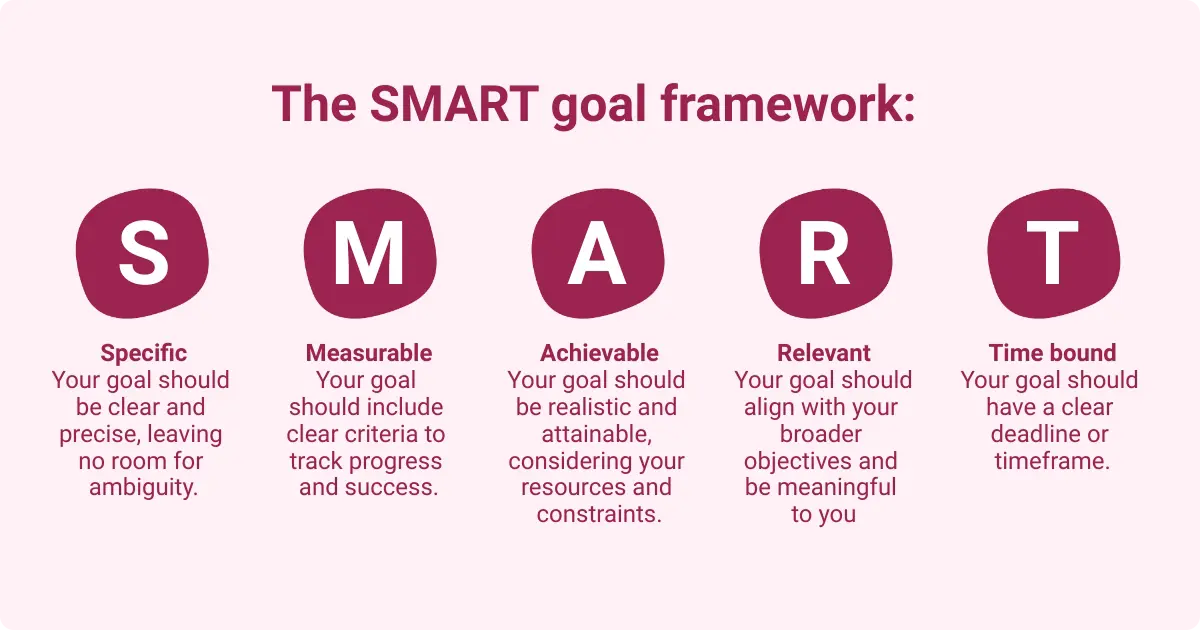
Review: tracking progress and refining the approach
The final step ensures that coaching isn’t just a one-time conversation – but an ongoing process of learning and adaptation.
The coach might ask:
- “Let’s summarize your action steps. What feels most achievable?”
- “How will you hold yourself accountable?”
- “Let’s check in two weeks from now – what will success look like by then?”
Example: The engineer starts using their new approach, and in a follow-up session, they discuss progress, obstacles, and refinements. If a new issue arises – like a coworker missing deadlines – the coaching cycle loops back to contract, listen, and explore.
Why the CLEAR model is so powerful
CLEAR prioritizes trust and reflection over quick fixes. Unlike models that jump straight to solutions, CLEAR ensures that the coachee feels heard, understood, and supported before moving into action.
This makes it ideal for:
Leadership coaching, where mindset and confidence are as critical as skills.
New managers or employees who may need space to process challenges before tackling solutions.
Coaching cultures in organizations where managers act as coaches rather than just evaluators.
By taking the time to listen and explore, the coach ensures that actions aren’t just temporary fixes—they’re rooted in real self-awareness and motivation.
Real-world example: supporting a new team lead
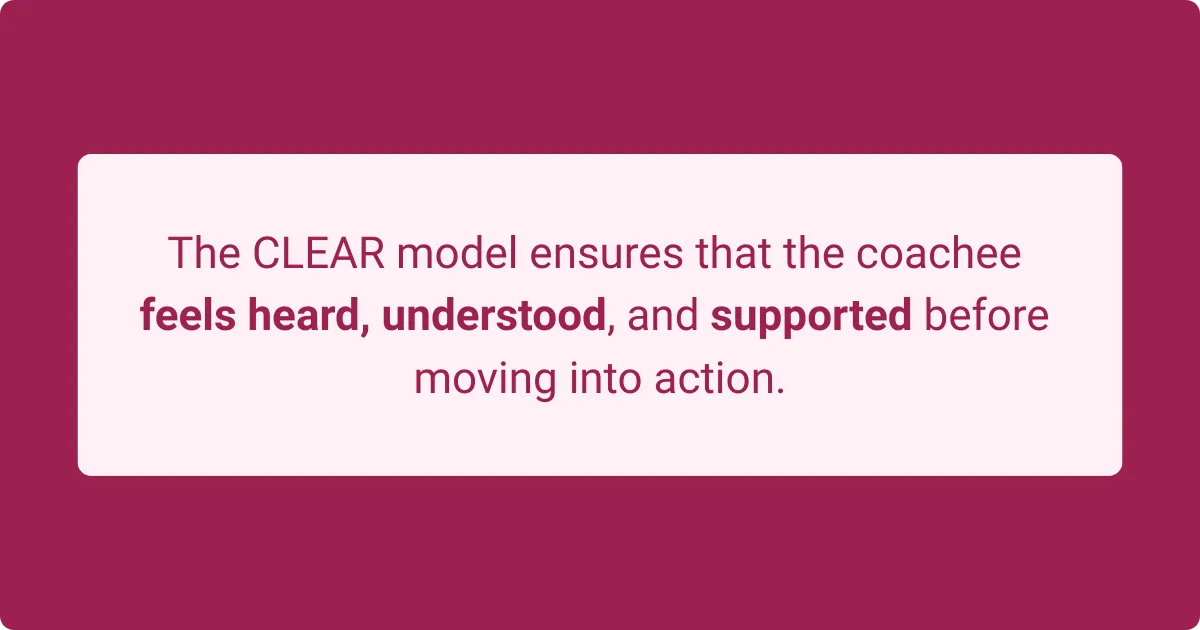
Asha, a senior software developer, recently stepped into a project lead role but is struggling with confidence and stress. Her manager decides to use the CLEAR model in their coaching session:
Contract: They agree that the session will focus on Asha’s adjustment to leadership with an open, confidential discussion.
Listen: Asha shares that she feels pressure to have all the answers and is afraid to delegate tasks.
Explore: The manager helps her examine this belief: “What makes you feel like you need to handle everything alone?” and “What would happen if you trusted your team more?”
Action: Asha decides to delegate a project module to a senior teammate and set up a weekly knowledge-sharing meeting to ease her anxiety about needing to “know it all.”
Review: They schedule a check-in in two weeks to see if these actions reduce Asha’s stress and improve project flow.
By the end of the session, Asha feels heard and supported and has a clear action plan – a perfect CLEAR outcome.
4. The FUEL model: Driving performance with structured dialogue
The FUEL model is a structured coaching framework designed to facilitate behavior change and performance improvement. Developed by John Zenger and Kathleen Stinnett, it is widely used in corporate leadership coaching and performance management. The acronym FUEL stands for:
- Frame the conversation
- Understand the current state
- Explore the desired state
- Lay out a plan
This method ensures coaching conversations are purposeful and productive, helping employees and leaders achieve measurable improvements while maintaining a collaborative and supportive tone.
Breaking down the FUEL coaching model
1. Frame the conversation: setting the stage for success
The first step establishes the purpose, process, and expectations for the coaching conversation. This is similar to the Contract phase in CLEAR, ensuring that both coach and coachee are aligned on the focus of the discussion.
Key elements include:
- Setting a positive, collaborative tone
- Clarifying the session’s goal
- Encouraging the coachee to contribute their own priorities
Example: A sales manager begins a session with a rep by saying:
“I’d like to discuss last quarter’s sales performance and how we can improve for this quarter. My goal is to support you in reaching your targets – does that sound good? What would you like to make sure we cover?”
This approach ensures alignment and engagement, making the coachee an active participant rather than a passive listener.
2. Understand the current state: diagnosing challenges and strengths
Next, the conversation focuses on the coachee’s present situation, including performance metrics, challenges, and perceptions. The coach listens actively, asking open-ended questions to gain a holistic understanding of what’s working and what’s not.
Key prompts include:
- “How do you feel about your performance last quarter?”
- “What challenges did you face?”
- “Can you walk me through your usual process?”
Example: A sales rep might reveal they struggled with prospecting new clients and felt uncertain about pitching a new product. Instead of jumping to solutions, the manager listens, asks clarifying questions, and shares relevant performance data to get the full picture.
The goal is to identify root causes without placing blame—sometimes, performance dips aren’t about effort but about technique, confidence, or external obstacles.
3. Explore the desired state: setting goals and identifying solutions
Now, the focus shifts from where the coachee is to where they want to be. The coach helps them define an ideal outcome and explore strategies for achieving it.
Key questions include:
- “What would success look like for you?”
- “What goals do you want to achieve this quarter?”
- “What approaches could help you get there?”
Example: The sales rep might say, “I want to hit 120% of my quota and feel more confident selling the new product line.” The coach helps brainstorm solutions, such as:
- Increasing outreach efforts
- Attending product training sessions
- Shadowing a top-performing sales rep
Importantly, this step doesn’t just focus on ideal outcomes – it also considers obstacles. The coach might ask, “What potential challenges could get in the way?” to ensure the plan is realistic and actionable.
4. Lay out a plan: turning ideas into concrete actions
Finally, the conversation moves to action planning. The coachee selects the most viable strategies, and the coach helps refine them into a structured plan with clear ownership and deadlines.
Key steps include:
- Identifying specific actions
- Setting deadlines and accountability check-ins
- Ensuring the coachee feels confident in their ability to follow through
Example: The sales rep’s action plan might include:
- Dedicate two hours every Tuesday to prospecting new leads (starting next week).
- Enroll in a product training webinar by Friday.
- Schedule one joint sales call with a top-performing colleague in the next two weeks.
- Hold a weekly check-in with the manager to review pipeline progress.
To solidify commitment, the coach might ask, “On a scale of 1-10, how confident are you in this plan?” If the coachee rates their confidence below an 8, they adjust the plan until it feels achievable.
Why the FUEL model is so effective
- It ensures every phase of coaching is covered – from diagnosing issues to locking in an action plan.
- It’s structured yet adaptable, making it ideal for performance coaching, leadership development, and skill-building.
- It makes employees active participants, increasing engagement and ownership of outcomes.
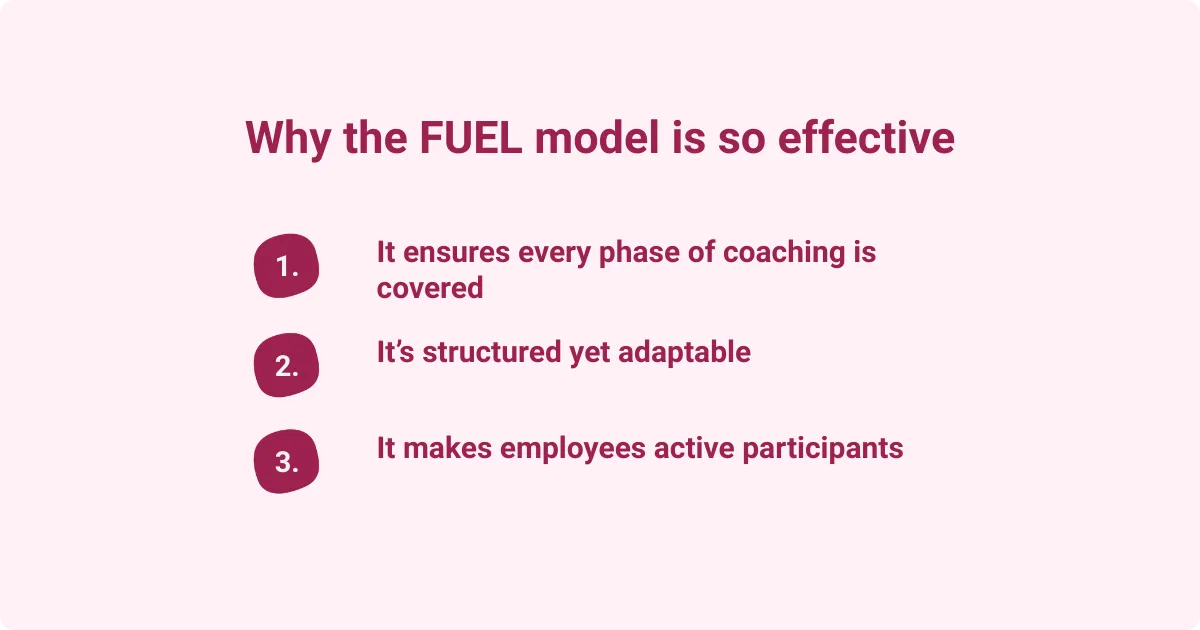
Unlike traditional performance reviews –where managers might simply dictate solutions – FUEL ensures that employees analyze their own performance, set their own goals, and commit to self-driven improvement.
Real-world example: coaching a new project manager
Alex, a newly promoted project manager, is struggling to balance deadlines and lead an inexperienced team. His supervisor uses the FUEL model in their coaching session:
Frame the conversation: They agree the goal is to help Alex manage his team effectively and stay on track with deadlines.
Understand the current state: Alex admits he tries to do everything himself, leading to burnout and missed deadlines. The supervisor listens, asks clarifying questions, and helps pinpoint the issue – a lack of effective delegation.
Explore the desired state: Alex envisions a smoothly running project where tasks are clearly assigned and the team takes ownership. Together, they brainstorm solutions:
- Implementing Agile sprints for better task management
- Holding weekly team check-ins to improve accountability
- Delegating tasks based on team strengths
- Seeking mentorship from a senior project manager
Lay out a plan: Alex commits to:
- Implementing a two-week sprint cycle
- Holding a kickoff meeting to delegate responsibilities
- Sending weekly progress emails to stakeholders
- Meeting with a mentor once a week for leadership guidance
By the end of the session, Alex has a structured plan, clear next steps, and a higher level of confidence. His supervisor leaves knowing Alex has concrete actions to take—not just vague advice like “delegate more.”
5. The STEPPA model: incorporating emotion into coaching
The STEPPA model is a powerful coaching framework developed by Dr. Angus McLeod that blends the emotional and cognitive aspects of goal achievement. Unlike traditional coaching models that focus purely on action and strategy, STEPPA ensures emotions and mindset are actively addressed, recognizing that they play a crucial role in performance and decision-making.
The acronym STEPPA stands for:
- Subject – define the topic of coaching
- Target – establish the goal or outcome
- Emotion – uncover emotional drivers and blockers
- Perception – explore beliefs and assumptions
- Plan – develop a strategy to achieve the goal
- Action – execute the plan with accountability
This model is particularly useful when a coachee’s emotions – such as fear, excitement, or self-doubt – affect their ability to move forward.
Breaking down the STEPPA coaching model
Subject: defining the coaching focus
The first step sets the context by identifying what area of the coachee’s work or life needs improvement. This could be broad (e.g., career development) or specific (e.g., improving public speaking skills).
Key questions include:
- “What aspect of your performance or development would you like to focus on?”
- “What challenge or opportunity are you currently facing?”
Example: A coachee might say, “I want to become a better public speaker.” This provides a clear starting point for the coaching conversation.
Target: setting a clear, measurable goal
Now, the conversation shifts to defining a specific outcome within the chosen subject. This is similar to the goal-setting phase in GROW, ensuring the objective is concrete and actionable.
Key questions include:
- “What specific result do you want to achieve?”
- “How will you measure success?”
- “What is your timeframe for reaching this goal?”
Example: Instead of a vague goal like “improve public speaking,” the target becomes:
- “Deliver a confident, engaging presentation at the annual conference next quarter.”
This adds structure and measurability, making it easier to track progress.
Emotion: uncovering feelings that drive or hinder success
This step sets STEPPA apart from other models. Here, the coach helps the coachee identify emotions tied to their goal, as well as any fears or anxieties holding them back.
Key questions include:
- “How do you feel about working toward this goal?”
- “What emotions arise when you think about achieving (or struggling with) this?”
- “Which emotions are motivating you, and which might be blocking you?”
Example: The aspiring public speaker might express a mix of fear (of embarrassment), excitement (about the opportunity), anxiety (about being judged), and determination (to prove themselves).
Understanding these emotions is critical for coaching success. If fear dominates, coaching might involve overcoming anxiety through visualization techniques or gradual exposure to smaller speaking events. If excitement is high, the coach might encourage them to channel that energy into practice and preparation.
Perception: challenging beliefs and assumptions
This phase explores the coachee’s mindset around their goal. People often hold limiting beliefs that shape their actions – coaching helps uncover and reframe these beliefs.
Key questions include:
- “What story are you telling yourself about this goal?”
- “What assumptions might be holding you back?”
- “Can we challenge or reframe these perceptions?”
Example: The coachee might believe:
- “Great speakers are naturally charismatic – I’m not.”
- “I failed at public speaking once before, so I’ll fail again.”
The coach challenges these perceptions by providing evidence to the contrary or using reframing techniques like:
- “Many great speakers started out nervous – confidence is a skill you can build.”
- “That one experience doesn’t define your ability – what did you learn from it?”
Adjusting limiting beliefs can dramatically change behavior, making the coachee more open to taking action.
Plan: creating a strategy for success
Now, with emotional and perceptual barriers addressed, the coachee is ready to develop an action plan.
Key steps include:
- Outlining key tasks and milestones
- Ensuring the plan addresses both skill development and emotional readiness
- Building in accountability measures
Example: A plan for improving public speaking might include:
- Join a public speaking workshop by next month
- Practice in front of colleagues or family to gain confidence
- Use breathing exercises before speaking to manage stage fright
- Study TED Talks to learn from great speakers
The plan is tailored not just to improve skills but also to manage emotions and reshape perceptions – ensuring a well-rounded approach to success.
Action: executing the plan with commitment
The final step is about taking action. The coach encourages the coachee to follow through and helps them stay accountable.
Key steps include:
- Setting deadlines for action items
- Tracking progress and making adjustments
- Reviewing outcomes in future coaching sessions
Example: If the coachee commits to practicing in front of colleagues, the coach follows up in the next session to ask:
- “How did it feel? What did you learn?”
- “What adjustments would you make for next time?”
This closes the loop and ensures that coaching drives real progress.
Why the STEPPA model is so valuable
It acknowledges that emotions drive behavior – ensuring they are discussed rather than ignored.
It helps coachees develop emotional intelligence, which can unlock deeper motivation and confidence.
It is especially useful in leadership coaching, where confidence, self-perception, and emotional resilience play a major role.
Unlike models that focus only on actions, STEPPA ensures internal barriers are addressed, making success more sustainable.
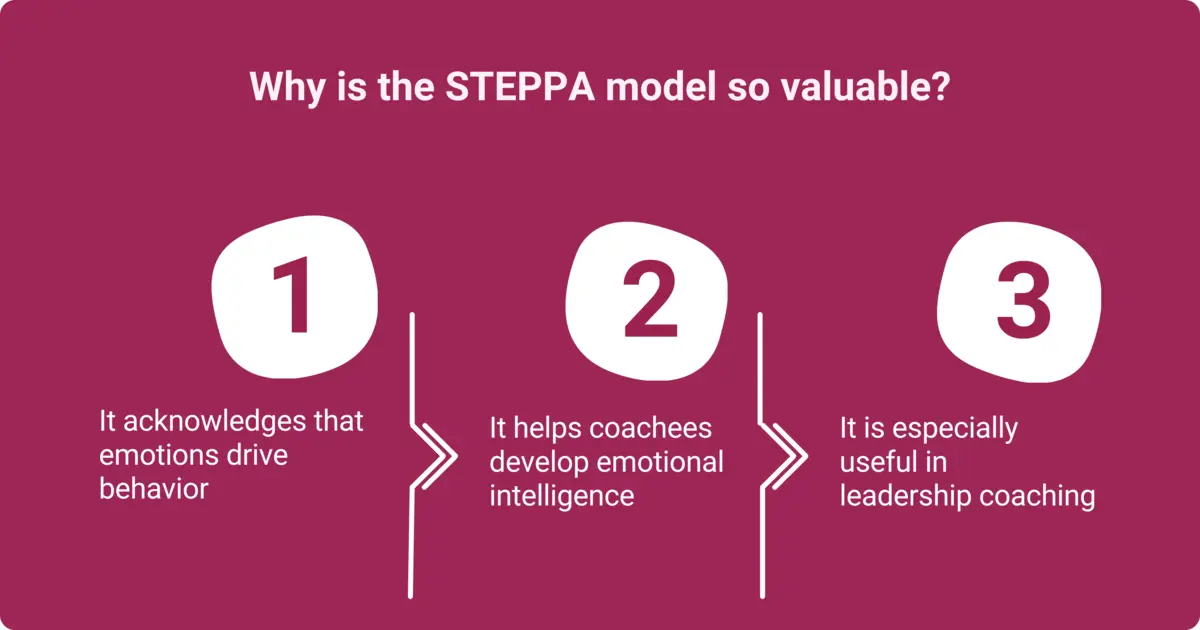
Real-world example: coaching a new leader
Nina, a high-potential employee, was recently promoted to lead a product launch – a major opportunity in her career. However, her manager notices that Nina seems hesitant and indecisive in meetings. Using the STEPPA model, they structure their coaching session:
Subject: Nina’s new leadership role and her hesitation in decision-making.
Target: Successfully leading the product launch, delivering on time, on budget and with a cohesive team.
Emotion: Nina admits she feels overwhelmed and fearful of failure but also excited about the opportunity.
Perception: She believes, “A strong leader has to have all the answers – I don’t.” The coach challenges this, reframing leadership as facilitating team input and making decisive choices rather than doing everything alone.
Plan: Nina commits to:
- Hosting a brainstorming session to involve her team in decision-making.
- Seeking mentorship from a senior leader for guidance.
- Practicing making smaller decisions quickly to build confidence.
- Using a meditation app to manage stress.
Action: Over the next month, Nina implements the plan, gaining confidence and decisiveness.
By addressing both internal and external factors, STEPPA ensures that Nina’s growth is not just about productivity—it’s about mindset, resilience, and leadership identity.
6. The WOOP model: science-backed goal achievement
The WOOP model is a psychology-based coaching framework developed by Dr. Gabriele Oettingen. Unlike traditional coaching models, WOOP blends positive visualization with obstacle planning, making it a powerful, science-backed tool for achieving goals.
The acronym WOOP stands for:
- Wish – identify a meaningful goal
- Outcome – visualize the best possible result
- Obstacle – recognize internal barriers
- Plan – create an if-then strategy to overcome obstacles
WOOP is widely used for personal development, behavior change, and performance improvement, making it a valuable addition to both coaching and self-coaching practices.
Breaking down the WOOP coaching model
Wish: defining a meaningful goal
The process begins with identifying a personal or professional goal that is challenging but achievable. The goal must be personally meaningful to tap into intrinsic motivation.
Key questions include:
- “What is a goal that is really important to you right now?”
- “What change would make the biggest difference in your success?”
Example: A coachee might say, “I wish to increase my department’s productivity without burning people out.” This wish provides clarity and focus, ensuring the coaching conversation is goal-driven.
Outcome: visualizing success
Once the wish is set, the coachee imagines the best possible outcome for achieving it. This step helps generate excitement and motivation by reinforcing the benefits of success.
Key questions include:
- “If you achieve this goal, what is the best thing that would happen?”
- “How would it feel to succeed?”
- “What positive impact would this have on you and others?”
Example: The coachee envisions, “Our team consistently meets targets, morale is high, and I am recognized as a strong leader.” This mental image strengthens motivation and makes the goal feel more tangible.
Obstacle: identifying personal roadblocks
This is where WOOP diverges from simple positive thinking – instead of assuming success, it asks: what internal habits, emotions, or thought patterns could prevent this goal from happening?
Key questions include:
- “What personal habit, belief, or behavior might get in your way?”
- “What has stopped you from achieving this goal in the past?”
- “How do you usually react when facing difficulties?”
Example: The coachee realizes, “I tend to micromanage and take on too much myself, which could lead to burnout for me and stress for my team.”
This step forces the coachee to confront reality and pinpoint internal roadblocks rather than only blaming external circumstances.
Plan: creating an if-then strategy
Now, the coachee creates a concrete action plan to overcome the obstacle when it arises. The key to WOOP’s effectiveness is if-then planning, which has been shown in research to increase follow-through.
Key questions include:
- “When your obstacle arises, how will you respond?”
- “What specific action will help you stay on track?”
- “How can you make it easier to follow through?”
Example: The coachee develops an if-then plan:
- “If I catch myself micromanaging, then I will identify one task to delegate the next morning.”
- “If I feel overwhelmed by the workload, then I will schedule a 15-minute prioritization session.”
This preemptive problem-solving makes it easier to stay on course when obstacles inevitably appear.
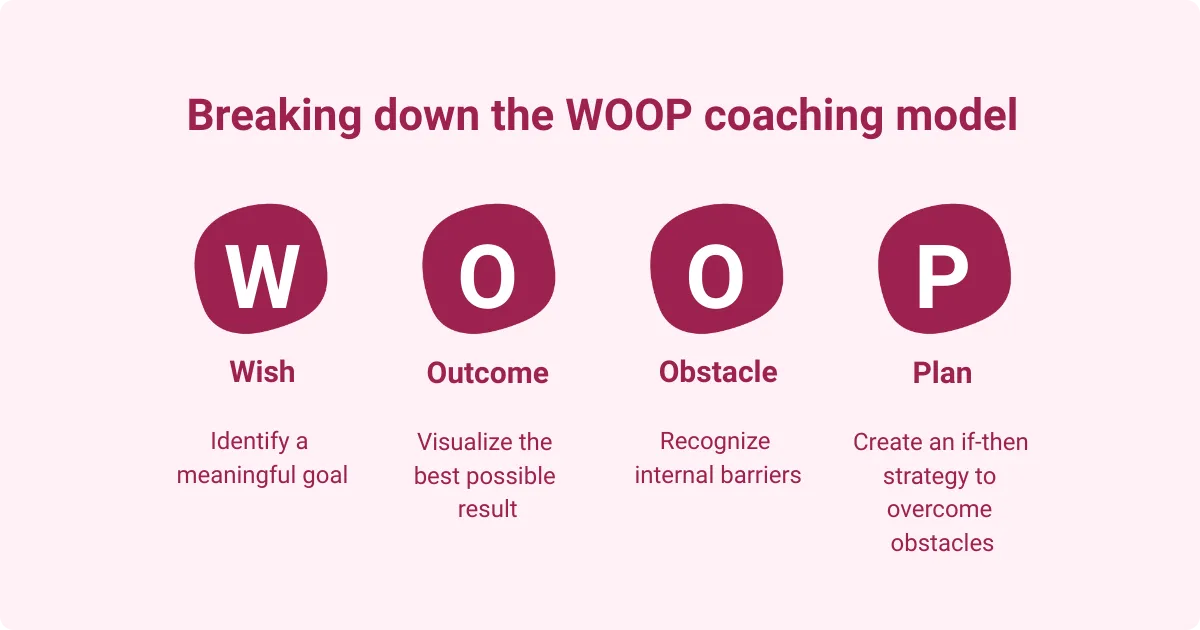
Why WOOP is so effective
- It blends optimism with realism – Unlike pure positive thinking, WOOP ensures obstacles are anticipated and planned for.
- It’s backed by research – Studies show mental contrasting (visualizing success + identifying barriers) improves motivation and goal achievement.
- It’s simple and repeatable – Coachees can use WOOP as a daily or weekly tool for professional and personal growth.
WOOP is particularly useful for habit change, productivity coaching, developing new leaders, and overcoming procrastination. It is also a great tool for self-coaching, helping individuals stay accountable between coaching sessions.
Real-world example: coaching a team leader on organization
Marco, a team leader, struggles with organization and meeting deadlines. His coach introduces WOOP to help him take control of his schedule:
Wish: Marco’s goal is to “become more organized and proactive in my work.”
Outcome: He envisions “finishing projects ahead of schedule, feeling in control, and earning recognition for his reliability.”
Obstacle: After reflection, Marco admits, “I procrastinate when tasks feel boring, and I get easily distracted by emails and Slack messages.”
Plan: He creates two if-then plans:
- “If I start to procrastinate, then I will break the task into a 15-minute chunk and just start.”
- “If I get distracted by email or Slack, then I will close those apps for one hour and set a focus timer.”
Over the next few weeks, Marco practices this method and reports significant improvement. By anticipating obstacles, he is no longer thrown off course when they arise. In fact, he finishes a report a day early – a first for him. Encouraged by his success, he even teaches the WOOP method to a team member struggling with procrastination.
7. Peer coaching model: coaching as a two-way street
Not all coaching is top-down (boss-to-employee or coach-to-client). Peer coaching is an increasingly popular approach where colleagues coach each other in a structured, reciprocal format. This coaching technique is especially valuable in organizations that aim to build a coaching culture, foster collaboration, and encourage knowledge sharing.
Unlike other coaching frameworks, peer coaching isn’t about hierarchy – instead, it’s a partnership focused on mutual development. Participants take turns being the coach and coachee, supporting each other’s growth through structured conversations and reflective questioning.
Key characteristics of the peer coaching process
Reciprocal relationship
Both participants are equals, alternately playing coach and coachee roles. This removes the power dynamics found in traditional coaching relationships, leading to more open, candid discussions.
Example: Two managers from different departments might pair up for bi-weekly coaching sessions, switching roles each time. One week, Alice coaches Bob on delegation strategies; the next, Bob coaches Alice on performance management challenges.
Structured process
While peer coaching is flexible, it works best with clear guidelines. Many organizations use established coaching models (like GROW or CLEAR) to guide sessions. To ensure effectiveness, companies might:
- Set expectations (e.g., confidentiality, active listening, open-ended questioning)
- Schedule regular sessions (e.g., bi-weekly or monthly)
- Pair employees across teams to provide fresh perspectives
Focus on learning and development
Peer coaching is ideal for ongoing professional development, problem-solving, and developing new skills. It allows colleagues to discuss challenges they might hesitate to share with their manager.
Example: A new manager might feel uncomfortable telling their boss, “I struggle with giving negative feedback.” But in a peer coaching session, they can openly discuss this issue with another manager, brainstorm solutions, and practice difficult conversations in a low-pressure environment.
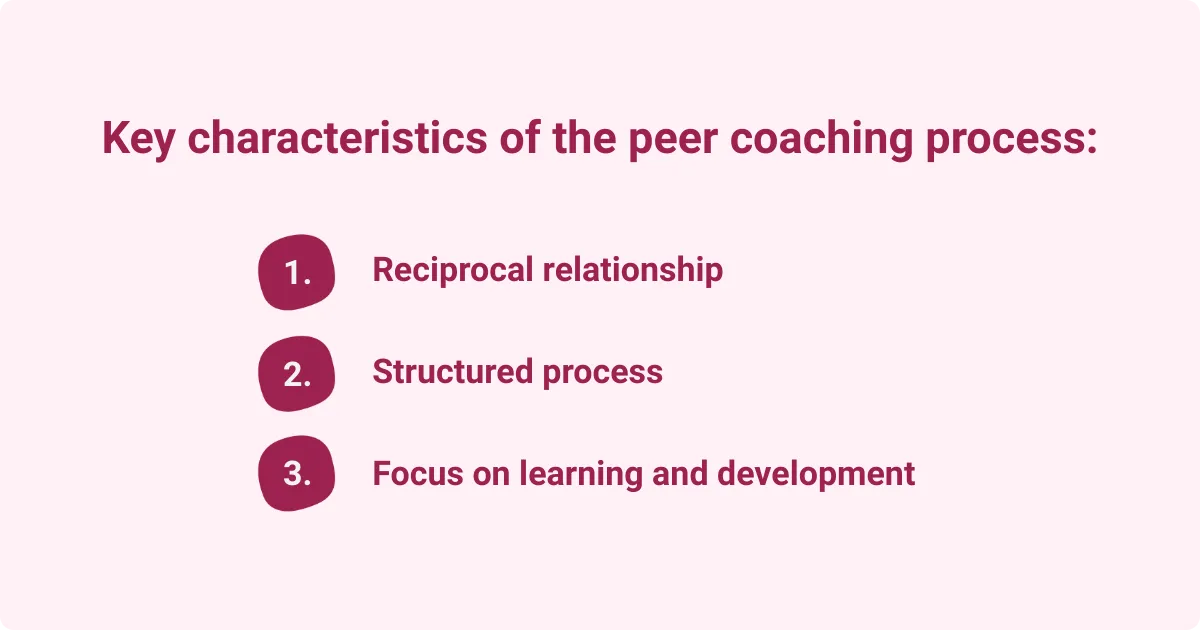
Why peer coaching is effective
Fosters a supportive culture – Encourages a continuous learning culture and breaks down workplace silos.
Develops coaching skills across all levels – Helps employees build deep listening, questioning, and empathy, which are key leadership traits
Low-cost and scalable – Unlike external coaching programs, peer coaching can be implemented without major expenses
Strengthens cross-team collaboration – Colleagues from different departments gain insight into each other’s work, forming stronger relationships
Peer coaching is backed by research. Workhuman studies suggest that a successful coaching culture isn’t just about manager-led coaching—employees at all levels should engage in coaching conversations. By making coaching a shared responsibility, organizations create a workplace where support, feedback, and employee growth and development occur organically.
Real-world peer coaching formats
Action learning groups – Small peer groups (4-6 people) meet to coach one participant at a time on a real challenge. Instead of offering direct advice, peers ask powerful questions, helping the coachee arrive at their own solution.
Buddy systems – New hires or employees attending a training program pair up to coach each other on applying their learning in real-world scenarios.
Cross-functional coaching pairs – Employees from different teams coach each other, providing fresh perspectives on challenges and breaking down departmental silos.
Real-world example: coaching first-time managers
A large tech company launches a peer coaching program for new managers. Alice (from Engineering) and Bob (from Marketing) are paired as peer coaches. They receive basic training in the GROW model and active listening before starting monthly coaching sessions.
Alice coaches Bob: Bob’s challenge is delegation – he’s overwhelmed with work but struggles to trust his team with key tasks. Alice listens, asks powerful questions, and helps Bob come up with an action plan: assigning one major task per week to a senior team member.
Bob coaches Alice: Alice is struggling with managing an underperforming engineer. Bob, with his marketing background, provides a fresh perspective – he helps Alice reframe the conversation as a growth opportunity rather than a disciplinary action. Together, they build a plan for a productive performance discussion.
Outcomes:
- Alice and Bob improve their management skills and confidence.
- They develop a cross-functional friendship, strengthening collaboration between Engineering and Marketing.
- By the end of the program, both managers feel more supported and capable in their roles.
How peer coaching sessions enhance workplace culture
Peer coaching doesn’t replace manager-to-employee coaching or professional coaching, but it enhances a company’s overall development ecosystem. When coaching is embedded into daily interactions, employees naturally adopt a growth mindset, supporting each other in a collaborative, human-centric way.
Workhuman’s research emphasizes that organizations with strong coaching and feedback cultures see better engagement, retention, and performance. Peer coaching is a cost-effective, scalable way to make coaching accessible to all employees – not just executives or high performers.
By creating a network of peer coaches, organizations empower employees to lead, learn, and grow together – making work more connected, supportive, and fulfilling.
FAQ
What is the best coaching model for beginners?
The GROW model is ideal for beginners due to its simplicity and structured approach. It guides conversations through Goals, Reality, Options, and Way Forward, making it easy to follow while ensuring clear, action-oriented outcomes for both the coach and the coachee.
Can I use multiple coaching models simultaneously?
Yes! Many coaches blend models depending on the coachee’s needs. For example, you might use WOOP for goal-setting, CLEAR for deep listening, and STEPPA to address emotional barriers. Combining models enhances flexibility and allows for a more personalized coaching experience.
What’s the most effective coaching model for employee performance?
The FUEL model is highly effective for improving employee performance because it emphasizes framing conversations, diagnosing challenges, exploring solutions, and creating action plans. It’s particularly useful in corporate settings, ensuring that coaching is both structured and results-driven.
What is the best coaching model for employee development?
The Peer coaching model is excellent for creating development programs for employees as it encourages collaborative learning, self-reflection, and skill-sharing among colleagues. It fosters a continuous coaching culture, making it scalable and cost-effective while enhancing leadership, communication, and problem-solving skills across all levels of an organization.
Conclusion
Effective workplace coaching isn’t one-size-fits-all – different coaching models serve different purposes, from performance improvement to leadership development.
Whether using GROW for structured goal-setting, WOOP for overcoming obstacles, or Peer Coaching for collaboration, the right model depends on the context. Many successful coaches combine multiple approaches to create tailored coaching experiences.
By integrating these frameworks into daily interactions, organizations foster continuous learning, engagement, and growth. The key is to empower employees with the right tools and mindset, ensuring that coaching isn’t just an event but a sustainable part of workplace culture.